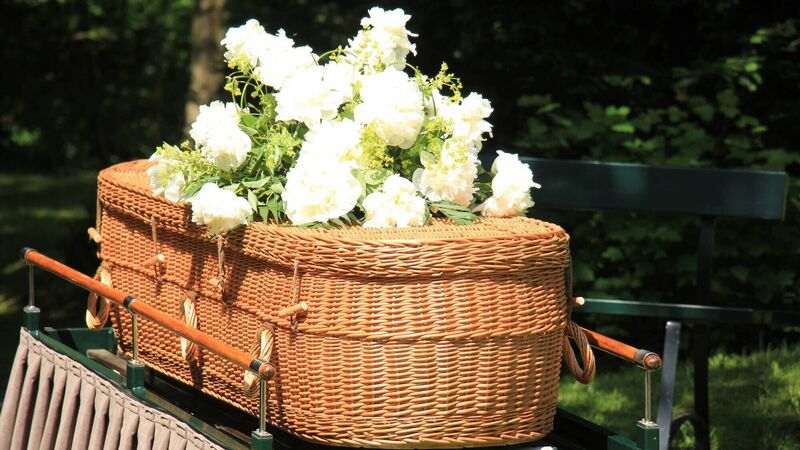Michelle McKeown: The greenest ways to go when you go

Natural burial: You’re wrapped in a biodegradable shroud or laid in a simple wicker or cardboard coffin and buried in a way that allows for natural decomposition
We spend our lives cleaning and recycling yogurt cartons, carrying reusable bags, and turning off the lights when we leave a room. But few of us stop to consider our final environmental footprint.
When all is said and done, how sustainable is our last great act... dying?
It turns out, not very.
It’s not the cheeriest topic, I’ll grant you, but if you’re reading this over a cup of tea, stay with me.
For most of Irish history, we’ve done things the traditional way. A wake in the house, a funeral mass, and a plot in the local cemetery. There’s comfort in that ritual; the sandwiches, the neighbours calling in, the sense of community.
But when it comes to carbon footprints, the old-fashioned burial isn’t exactly green. Traditional burials involve embalming chemicals (usually formaldehyde) and hardwood coffins. Those lawns need mowing and fertilising too. Multiply that by the thousands of burials each year and the environmental impact starts to look rather grim.
Then there’s the question of space. Ireland’s cemeteries are filling up fast. Dublin is already running short of burial plots, with similar issues emerging around Cork, Galway and Limerick. The result? Prices climbing as high as €10,000 for a plot in some Dublin areas. It’s an expensive and unsustainable send-off.
That might be why more and more Irish people are choosing cremation.
Back in 1980, fewer than 5% of Irish funerals involved cremation. Today, it’s much higher at around 20% with new crematoria popping up across the country. But while cremation saves space, it’s hardly the eco-option it’s often assumed to be. Each cremation releases between 200-400 kilograms of CO₂, depending on the crematorium’s efficiency. Plus trace emissions from burning coffins, varnish, and the occasional metal fitting.
And though filters can capture some pollutants, there’s no escaping the basic chemistry, which is that fire requires fossil fuel, and fossil fuel means carbon.
So, what’s the greenest way to go when your time comes?
Thankfully, a growing number of alternatives are helping us make more planet-friendly departures.

A natural burial is exactly what it sounds like, returning to the earth as gently as possible. No embalming fluid, no ornate coffin, no polished headstone. Instead, you’re wrapped in a biodegradable shroud or laid in a simple wicker or cardboard coffin and buried in a shallow grave that allows for natural decomposition. The result is quietly beautiful. Burial grounds are managed as wildflower meadows or native woodlands, supporting bees, birds, and biodiversity. There’s no noisy maintenance, no petrol mowers, just the slow, organic process of life continuing.
Ireland has several natural style burial grounds already, including Woodbrook in County Wexford, Killarney Burial Ground in Kerry, and Knockma Woodland Burials in Galway. Instead of rows of headstones, you might find a meadow dotted with trees or a woodland glade. Graves can be marked with simple wooden plaques, wildflowers, or GPS coordinates. It’s the kind of resting place you might actually want to visit. Peaceful, living, and alive with birdsong.
If you like your science clean and clever, this one’s for you. Water cremation, or aquamation, or resomation, uses a heated alkaline solution to gently accelerate the body’s natural breakdown. It’s essentially the same chemistry as decomposition, just sped up to take hours instead of years. Unlike fire cremation, aquamation uses only a fraction of the energy, emits no CO₂, and produces no harmful gases. The final product is a sterile powder (similar to ashes) that can be scattered or buried.
It’s already being used in parts of Britain, the US and Australia, and was famously chosen by Archbishop Desmond Tutu. In Ireland, the demand for this option could grow as Pure Reflections resomation facility opened here in 2023. In their first year of business they handled more than 100 funerals and more again the second year says Pure Reflections director, Elizabeth Oakes.
Then there’s the boldest option of all: human composting. Legal in several US states, this process (technically called 'natural organic reduction') transforms a body into nutrient-rich soil. The deceased is placed in a vessel with woodchips, alfalfa, and straw. Air is circulated to encourage microbial activity, and after about six weeks, you’ve become roughly one cubic metre of clean, fertile compost.
That compost can be used to nourish trees or restore degraded land. It’s carbon-negative, entirely chemical-free — and, dare I say it, poetic. It’s not available in Ireland, but attitudes are shifting. A generation ago, cremation was considered un-Irish. Now it’s mainstream. So, it’s not impossible to imagine a time when 'composting yourself' doesn’t raise an eyebrow at the pub.
If you want to go out in eco-style, there’s also the Infinity Burial Suit... a biodegradable jumpsuit laced with mushroom spores that digest your body and neutralise toxins as you decompose. It sounds like something from a sci-fi film, but it’s very real. Similarly, Dutch innovators have developed mycelium coffins, grown from fungi. They take just a week to make, break down entirely within 45 days underground, and enrich the surrounding soil.
If you died tomorrow (purely hypothetically), the most sustainable choice currently available in Ireland would be a natural burial. It’s low-carbon, local, and beautifully symbolic.
In the future, water cremation and human composting could take the lead, but for now, the infrastructure simply isn’t here.
In the meantime, even small choices make a difference. Opting for a biodegradable coffin, skipping embalming, or planting native trees in memory instead of marble headstones.
Death is, of course, unavoidable. But the mark we leave behind doesn’t have to be.
With a bit of planning, your last act on Earth could be one that gives something back, a tree, a meadow, a patch of pollinator paradise. Because as the old saying goes, you can’t take it with you; but you can leave a little something behind for the planet.









